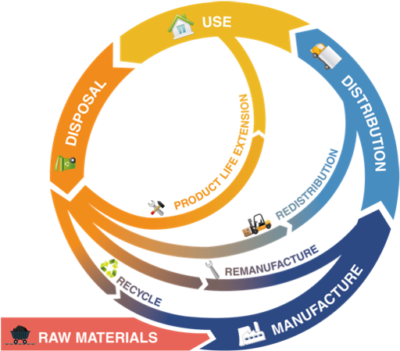How do we define a circular economy?
As implied in the name, it’s a circular, closed-loop system in which our planet’s finite resources are not trashed. According to the Ellen MacArthur Foundation, a circular economy is based on three key principles:
- Designing out waste and pollution
- Keeping products and materials in use
- Regenerating natural systems

Why does this matter?
First, an environmental perspective. Today, it takes the Earth about one year and eight months to regenerate the resources we use in a year. In other words, we would need at least 1.6 Earths to keep up with our global population’s consumption. But here’s the kicker – we only have one planet Earth. If I have $100 in the bank and I’m spending $1.60 per day, but only earning $1 per day, I’m going to bleed my account dry in no time. What happens when our planet Earth’s natural resource balance hits zero?
Aside from the fact that we’re using up the planet’s finite resources at an unsustainable (and increasing) rate, our linear economy has presented us with two other massive problems. The first problem: we’ve created a climate crisis from generating more greenhouse gas (GHG) emissions than our planet is capable of absorbing. In fact, roughly two-thirds of GHG emissions comes from the linear processes of extraction, manufacturing, and disposal of consumer products. Two-thirds! While the Paris Agreement set out to limit the increase in global average temperature to below 2 degrees Celsius (3.6 Fahrenheit), our linear economy is actually steering us to an estimated 3- to 6-degree temperature increase by 2050.
The second problem: we’ve created a waste crisis from all the resources we use and trash. Plastic waste, food waste, electronic waste – the list goes on. It’s easy to not give a second thought toward what we trash because we don’t see where it goes. Well, here’s where it goes:
- We’re polluting our oceans: If we keep up what we’re doing, research estimates that our oceans will contain more plastic than fish by 2050.
- We’re polluting our soil: landfill waste leaks hazardous chemicals into the soil and then into our food. Did you know that 82.8% of China’s soil has contaminants like mercury, arsenic, and lead?
- We’re polluting our air: incinerators burning our waste release toxic substances into the air, including extremely poisonous dioxin. In the U.S. alone, over 40% of the population is at risk of disease and premature death caused due to air pollution.
Now that we’ve covered the environmental aspect, let’s look at why a circular economy makes economic sense. Accenture calculates that a transition to a circular economy between now and 2030 is a whopping $4.5 trillion global economic opportunity. That’s more wealth than Germany’s entire economy! Yes, primary sectors engaged in commodity extraction and trading are likely to lose out – especially those involved in fossil fuels. However, there’s an upside: according to Walter Stahel – one of the founding thought leaders of the circular economy – reusing, remanufacturing, and recycling materials could produce 75% more jobs!

How do we get there?
So, the circular economy has some pretty great benefits. How do we get there? For starters, we need better policy measures. These include:
- Using market-based tools to address negative externalities like pollution and loss of natural capital. As an example, Canada currently prices its carbon at $40 per CO2 equivalent, and it’s set to incrementally rise until it reaches $170 in 2030.
- Introducing design mandates for new products that would allow ease of repair and maintenance, dismantling, and countering obsolescence. I’m looking at you Apple…
- Strengthening waste standards. Examples include source separation (i.e., separating our recyclables collected at the curb into different categories), composting programs to collect organic discards, and pay-as-you-throw systems, whereby you’re penalized for your trash. If you think that’s crazy, believe me, it’s already happening.
At the enterprise level, companies can adopt a variety of business models:
- Using renewable energy and either bio-based or fully recyclable inputs for supplies. We can look to Loliware as a terrific case study, which makes seaweed-based straws that are both compostable and edible.
- Extending product lifecycles by repairing, upgrading, and reselling, as well as through innovation and product design, like Patagonia’s Worn Wear program.
- Moving away from offering customers product ownership and, instead, offering them access to products. Michelin is a great example of this “product-as-a-service” model, leasing their tires and instead charging according to mileage. Since the manufacturer remains the owner of the product, they’re responsible for maintenance, repairs, as well as what to do with it at end-of-life.
Finally, we too, as individual citizens, have the power to help accelerate to a circular economy. We can play our part by:
- Minimizing our waste. Try to buy without packaging when possible.
- Buying local goods, supporting local and regenerative production systems to avoid unnecessary transportation, and supporting production with minimal environmental consequence.
- Changing our mindset that product ownership is no longer a sign of wealthiness. We need to share services and products upon our needs, instead of buying them individually.
Make no mistake – the circular economy is coming our way. But if we are to have a fighting chance in meeting our Paris goals, we can’t afford to wait. We need to catalyze our global adoption at a massive scale. Who exactly is working on such initiatives will be the subject of my next post.

